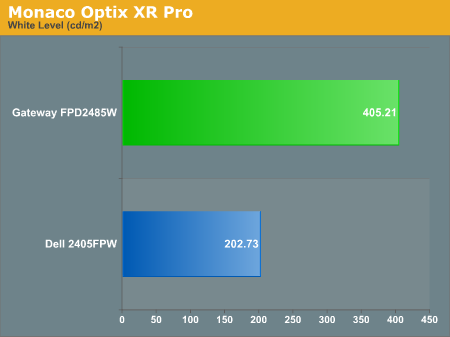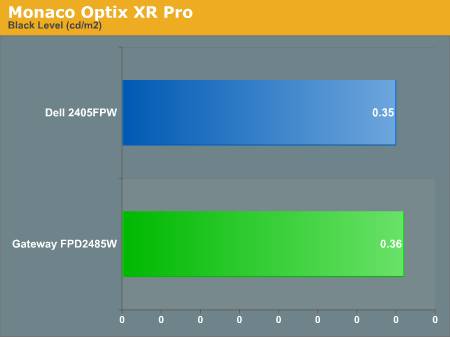Gateway FPD2485W: 24" LCD Beauty or Beast?
by Jarred Walton on February 22, 2007 10:00 AM EST- Posted in
- Displays
Brightness and Contrast Comparisons
As this is our first display review in quite some time, we don't have a large backlog of results with which to compare new displays. Given that many people are familiar with Dell's older 2405FPW we decided to provide results from our 18 month old Dell LCD for comparison. While we have heard of users that are experiencing backlight fade or other problems on older displays, our 2405FPW continues to perform admirably. We'll start by looking at brightness levels and contrast ratios.
For testing, we used a Monaco Optix XR (DTP-94) colorimeter on the hardware side. For software, we used Monaco Optix XR Pro. The software and hardware is relatively easy to use and helps users to fine tune their displays. We did find that the instructions tend to be a bit aggressive in terms of setting the contrast ratio, however, as we achieved better results by setting the Gateway LCD to a 60% contrast ratio instead of the 100% that was recommended.



Theoretically, you want your whites to be brighter and your blacks to be darker, and we have sorted the charts appropriately. Dividing the white point by the black point gives you the effective contrast ratio, with higher scores being better. The problem is, darker blacks are good but brighter whites are only good up to a certain point. Anything above 400 cd/m 2 is far too bright in our opinion. As you can see, the black levels of both the Gateway and Dell LCD are equal, so the Gateway LCD achieves better contrast ratios mostly by offering brighter whites. If you work in a well lit office environment, the Gateway system might be the better choice, but most users will likely end up running either LCD at similar brightness levels.
As this is our first display review in quite some time, we don't have a large backlog of results with which to compare new displays. Given that many people are familiar with Dell's older 2405FPW we decided to provide results from our 18 month old Dell LCD for comparison. While we have heard of users that are experiencing backlight fade or other problems on older displays, our 2405FPW continues to perform admirably. We'll start by looking at brightness levels and contrast ratios.
For testing, we used a Monaco Optix XR (DTP-94) colorimeter on the hardware side. For software, we used Monaco Optix XR Pro. The software and hardware is relatively easy to use and helps users to fine tune their displays. We did find that the instructions tend to be a bit aggressive in terms of setting the contrast ratio, however, as we achieved better results by setting the Gateway LCD to a 60% contrast ratio instead of the 100% that was recommended.



Theoretically, you want your whites to be brighter and your blacks to be darker, and we have sorted the charts appropriately. Dividing the white point by the black point gives you the effective contrast ratio, with higher scores being better. The problem is, darker blacks are good but brighter whites are only good up to a certain point. Anything above 400 cd/m 2 is far too bright in our opinion. As you can see, the black levels of both the Gateway and Dell LCD are equal, so the Gateway LCD achieves better contrast ratios mostly by offering brighter whites. If you work in a well lit office environment, the Gateway system might be the better choice, but most users will likely end up running either LCD at similar brightness levels.










77 Comments
View All Comments
strikeback03 - Friday, February 23, 2007 - link
You skipped quoting the rest of the paragraph:Optimal brightness setting for LCDs is often stated to be 120 cd/m^2. So in many circumstances the extra brightness of the Gateway isn't useful.
JarredWalton - Friday, February 23, 2007 - link
400 cd/m2 is the most I could imagine using, and once both LCDs were adjusted the actual white point was a lot closer - meaning even though the maximum on the Gateway was twice as high, once calibrated I didn't use anywhere near that white level. 300+ cd/m2 can be almost painful to look at in my opinion, and 400 or higher is generally overkill.The point is, the only reason Gateway and others seem to have such insane brightness levels is to get better contrast scores. Most people will run around 200 cd/m2, give or take probably 50. But if your black is only able to reach a minimum of 0.35 cd/m2, that means the contrast ratio would be somewhere between 500:1 and 600:1. The "solution" is to simply crank up the maximum brightness, so you can claim a 1000:1 (or even 1200:1) contrast ratio. More is better, right? Except, it's not, because hardly anyone will actually use those super-bright whites.
Also worth noting is that if you max out brightness and contrast (max white level), the color accuracy scores go to hell and the whites all run together, so everything from about 200 or higher on the RGB scale ends up as the same level of white. At maximum contrast, the recommended calibrated brightness (according to Monaco Optix) is 20%, where if I choose 60 contrast the recommended brightness is 61%. As mentioned in the review, the overall color accuracy was better with contrast set to 60 as opposed to 100.
The maximum brightness (100% contrast) was even higher than reported: 500 cd/m2 was pretty close, but black went up to 0.45 cd/m2. Depending on the room you work in, higher brightness may be okay or not. I prefer running closer to 200-300 personally.
DigitalFreak - Friday, February 23, 2007 - link
All I can say is that I love my 2405!Painman - Friday, February 23, 2007 - link
Besides the already requested input lag tests, modern LCD reviews usually include at least a few gaming tests... some commentary on what kind of visual artifacts are evident with fast moving objects. I had 3 of these Gateways (returned for various defects) and tried to like it, but aside from other problems the smearing was just too much to take... green and brown smudges always popping up in my face. I bought myself an IPS based NEC and I ain't looking back.This isn't a very good gamer panel... thinking about it now sitting in front of this NEC, I can't really say the Gateway FPD2485W is a good ANYTHING panel, tbh.
Aquila76 - Friday, February 23, 2007 - link
If you want to see something that'll blow your mind on this display, fire up HL2. At the menu screen, where it's out of focus as it loads the game, it looks like you've dropped to 256 Color mode and are 'dithering' the image. I noticed the same effect when hitting the Nitro in a couple Need for Speed games.knirfie - Friday, February 23, 2007 - link
This monitor features DCDi by Farudja, why is there no mention of this in the review (or did I miss it?). And how is the videoquality/deinterlacing over composite/svideo/component?DigitalFreak - Friday, February 23, 2007 - link
Page 3:Souka - Friday, February 23, 2007 - link
get an apple cinema display and make sure its calibrated properly....nothing better IMHO... use them all the time at work. Some folk have those Dell units...yuk....color is off, things seem dull, despite all calibration attempts.
Good thing they're just doing web page design and programming....
dcr - Thursday, February 22, 2007 - link
Could you test WoW and see if you get this "flashing" in the terrain?chizow - Thursday, February 22, 2007 - link
Jarred, nice review of the 2485W, was wondering if you wouldn't mind posting your settings after you calibrated your display with Optix. Reason I ask is that myself and many others felt the color accuracy out of the box on this panel were horrible, especially compared to other displays. I was able to get better results by asking what settings people were using, and obviously what looks good to them will vary person to person and card to card, but it was a big help.Also, it might be worth noting what month your panel was made. There were some serious issues with this panel in early production runs (November), but each successive month seems to correct problems and greatly reduce other problems. Backlight bleed seems to greatly diminish as well as an annoying PSU buzzing problem with newer models.
Lastly, I was glad you mentioned the 1:1 pixel mapping, but I think there needs to be greater emphasis on this aspect of 24" panels or any panel able to do 1920x1080. In the era of HD with all of the inputs this monitor and some competitor models provide (BenQ, Dell Rev. A04), the ability to do 1:1 is a major consideration for the enthusiast. If you have multiple HD capable devices (HDTV, PS3, Xbox360, HD-DVD, Blu-Ray) this monitor can basically serve as your entertainment center, all while maintaining its main functionality as a massive 2.3 Megapixel PC display. There's really few other tech-enabling devices I've purchases that can compete with this panel's versatility and functionality.